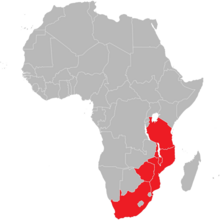User:Coleopterad/Goliathus albosignatus
| This is the sandbox page where you will draft your initial Wikipedia contribution.
If you're starting a new article, you can develop it here until it's ready to go live. If you're working on improvements to an existing article, copy only one section at a time of the article to this sandbox to work on, and be sure to use an edit summary linking to the article you copied from. Do not copy over the entire article. You can find additional instructions here. Remember to save your work regularly using the "Publish page" button. (It just means 'save'; it will still be in the sandbox.) You can add bold formatting to your additions to differentiate them from existing content. |
Article Draft
[edit]
| Coleopterad/Goliathus albosignatus | |
|---|---|

| |
| Scientific classification | |
| Domain: | Eukaryota |
| Kingdom: | Animalia |
| Phylum: | Arthropoda |
| Class: | Insecta |
| Order: | Coleoptera |
| Family: | Scarabaeidae |
| Genus: | Goliathus |
| Species: | G. albosignatus
|
| Binomial name | |
| Goliathus albosignatus Lamarck, 1801
| |
Lead
[edit]Goliathus albosignatus is a species of beetle of the family Scarabaeidae, described by Boheman in 1857. It is one of several species of Goliath beetles that inhabit Africa, but it is the only one exclusively found in subtropical sections of the continent. [1]
Description
[edit]Goliathus albosignatus can reach a length of about 45–70 mm (1.8–2.8 in) in males, of about 40–50 mm (1.6–2.0 in) in females. There are distinctive nonuniform bands of black that go horizontally across their elytra and differentiate it from other species. While Goliath beetles are one the largest beetles on Earth, this is the smallest of the species and are not as commonly found as the others. [2] Sexual dimorphic traits are also present in Goliath beetles and include males having a Y shaped horn protruding from their head to assist with confrontation between males, while in females the horn is absent and their wedge-shaped head is fit for digging the burrows where eggs are to be laid. [3]
Biology
[edit]Development of Goliathus albosignatus is carried out in Hyrax dung which is a trait shared with Fornasinius species, but not among any other Goliath beetles. [4] Their diet consists of high protein as larvae, but after pupating into adulthood, they have been known to feed on sap from Acacia. [5][6] Other behaviour of note is they will gather on Marula trees, specifically Sclerocarya birrea.[6]

Taxonomy
[edit]Goliathus albosignatus is taxonomically separated from the other species in Goliathus according to barcoding analysis results that were published in Entomologia Africana in January 2020. Characteristics differentiating Goliathus albosignatus that are mentioned include "hammer-shaped post-clypeal horns of the male, the elongated tarsi, and the presence of cretaceous marks on the pygidium".[4]
Subspecies
[edit]There are 2 subspecies:
- Goliathus albosignatus albosignatus Boheman 1857
- Goliathus albosignatus kirkianus Gray, 1864
Subspecies distributions and sizes
[edit]- Goliathus albosignatus albosignatus:
Distribution: Middle to South Zimbabwe and North-Eastern South Africa; Size: ♂ 40 – 68 mm; ♀ 45 – 52 mm.
- Goliathus albosignatus kirkianus:
Distribution: Malawi, Mozambique and Tanzania; Size: ♂ 40 – 71 mm; ♀ 45 – 55 mm.
Reference
[edit]- ^ Goliathus albosignatus Boheman, 1857 in GBIF Secretariat (2021). GBIF Backbone Taxonomy. Checklist dataset https://doi.org/10.15468/39omei accessed via GBIF.org on 2021-10-26.
- ^ "Goliathus - Goliathus albosignatus gallery". www.naturalworlds.org. Retrieved 2021-10-27.
- ^ "Goliathus - The African Goliath Beetles". www.naturalworlds.org. Retrieved 2021-10-28.
- ^ a b "Entomologia africana African entomological society". www.entomoafricana.org. Retrieved 2021-10-28.
- ^ Cite error: The named reference
:0was invoked but never defined (see the help page). - ^ a b "Goliathus - Goliathus albosignatus". www.naturalworlds.org. Retrieved 2021-10-28.
